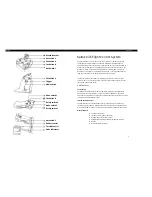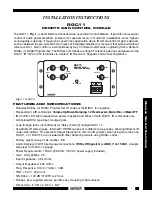
USER'S GUIDE
AMTOR OPERATING SUGGESTIONS FROM G3PLX
PK232UG Rev. E 9/87
D-2
180
2.5.
Finally, make an ARQ call to the distant station and attempt an ARQ contact with your sta-
tion as master rather than, as in 2.4, as a slave. If no contact results, yet the distant station
indicates that he was replying to the call, then the problem is that the radio is too slow to
change from transmit to receive. Remedial work may be required to correct this. No adjust-
ment to the 'delay' preset in the AMTOR unit, if fitted, will cure this problem. Consult the
supplier of your radio if remedial work is needed.
It is important to follow these steps in order. Unnecessary confusion, frustration, and inter-
ference can result from a premature attempt to start an ARQ contact where the complete
contact cannot be made until all the component parts are working correctly.
3. AMTOR operating techniques
AMTOR is sufficiently different from other modes that some of the operating practices tradi-
tionally used on the air, are no longer appropriate, and some new techniques peculiar to AM-
TOR need explaining.
3.1.
FEC and ARQ. When to use them
ARQ is well-known to be the better of the two, but there are several situations where FEC
has its advantages, and some where its use is essential.
3.1.1.
Use ARQ for all two-way contacts.
3.1.2.
Use FEC for all multi-way contacts.
3.1.3.
Do not use ARQ for CQ calls. There are several reasons for this:
3.1.3.1.
Listeners cannot identify the calling station in an ARQ CQ call. Thus they either must
risk replying to a station with whom contact was not desirable, or suffer the embarrass-
ment of having to terminate a contact if, for example, it turns out to be the station you
have just worked.
3.1.3.2.
If a contact which resulted from a CQ call on ARQ subsequently runs into a re-phasing
attempt, the resultant CQ call from the master station may attract a completely new re-
ply from a third station, thus resulting in this new station 'stealing' the contact.
3.1.4.
FEC will have to be used if the distance between the two stations is longer than about
22,000 miles, such as in 'long path' contacts which travel more than halfway round the
globe, or some high orbit satellite contacts. Make sure you know in advance if the path
you are attempting is in this category, and do not attempt ARQ under these conditions; it
is very frustrating to be called on ARQ when it is known that the path is too long, and
very difficult to attract the attention of the caller to the problem.
3.2.
Starting an AMTOR QSO
There is no need to explain how to start an FEC QSO, since the technique is identical to that
on other modes. However, since in ARQ mode it is necessary to know the other station's
SELCAL code before calling him, a new technique must sometimes be required.
3.2.1.
If the other station's SELCAL code is already known, as in the case of a 'sked', then there
is no problem. Simply enter the required SELCAL code to the AMTOR unit, and if/when
the desired station is on frequency, he will reply and the contact can proceed.
















































